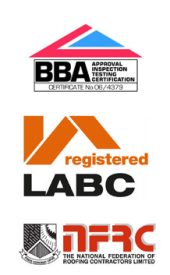The temperature inside most houses is maintained at a comfortable level of around 20°C in living areas and 17°C in bedrooms. In the UK, the outside temperature is generally lower than this, especially in the winter. Heat flows from the warmer interior of the house, through the fabric of the building, to the outside. The U-value expresses the rate at which heat is lost through a part of the house – such as roof, walls or windows. The U-value is expressed in units of Watts of power for every square metre of roof and for every degree temperature difference between the inside and the outside, or W/m².K.
Part L1B 2010 requires a renovated roof to have a U-value of 0.18 W/m².K. If the roof has an area of 70 square metres, and the temperatures inside and outside are 17 and 5°C, then the rate of heat loss through that roof is:
0.18 x 70 x (17 – 5) = 151 Watts
The U-value of a roof is calculated by breaking the roof structure down into separate layers – such as plasterboard, insulation, rafters and underlay. The thermal resistance of each component is added together. Any materials of high thermal conductivity, such as timber rafters, form a cold bridge through the structure, and must be accounted for in the calculation, as must fixings and any poorly fitted insulation. The inverse of the total thermal resistance of the roof, corrected for cold bridging and other factors such as fixings, gives the U-value for that roof structure. Examples of U-value calculations are shown in the TLX Silver solutions.
All TLX Silver U-value calculations are carried out according to BS EN ISO 6946.
In general, the water vapour pressure inside the house is greater than the vapour pressure outside. As well as heat trying to escape the building, so too water vapour tries to escape through the building fabric to the outside. The main mechanism by which water vapour is eliminated should be through adequate ventilation. However, vapour will also try to diffuse through the walls and roof.
Water vapour coming into contact with a cold surface will condense, as can be seen on the inside of windows after a cold night. Condensation within the structure of the roof, known as interstitial condensation, can have adverse effects. Excess water can lead to mould growth, or staining of interior plaster or timbers. To prevent interstitial condensation, the roof structure must be built such that materials with higher vapour resistance are positioned to the inside of the building. This prevents water vapour from penetrating the wall structure to a cold part of the roof. TLX Silver is a vapour barrier, and has a very high vapour resistance. When it is located on the inside of the roof it prevents water vapour from getting into the roof structure, eliminating the risk of interstitial condensation.
TLX Silver standard solutions contain an analysis of the risk of interstitial condensation, calculated to BS EN ISO 13788, which show no risk of harmful condensation. The calculation assesses diffusion of water vapour through the materials of construction, but not water vapour in moist air that leaks into the roof structure. It is essential that the ceiling is as well sealed as possible to prevent movement of moist air from carrying water vapour into the roof.


© Copyright 2024. All Rights Reserved.
| Cookie | Duration | Description |
|---|---|---|
| cookielawinfo-checkbox-analytics | 11 months | This cookie is set by GDPR Cookie Consent plugin. The cookie is used to store the user consent for the cookies in the category "Analytics". |
| cookielawinfo-checkbox-functional | 11 months | The cookie is set by GDPR cookie consent to record the user consent for the cookies in the category "Functional". |
| cookielawinfo-checkbox-necessary | 11 months | This cookie is set by GDPR Cookie Consent plugin. The cookies is used to store the user consent for the cookies in the category "Necessary". |
| cookielawinfo-checkbox-others | 11 months | This cookie is set by GDPR Cookie Consent plugin. The cookie is used to store the user consent for the cookies in the category "Other. |
| cookielawinfo-checkbox-performance | 11 months | This cookie is set by GDPR Cookie Consent plugin. The cookie is used to store the user consent for the cookies in the category "Performance". |
| viewed_cookie_policy | 11 months | The cookie is set by the GDPR Cookie Consent plugin and is used to store whether or not user has consented to the use of cookies. It does not store any personal data. |
Error: Contact form not found.